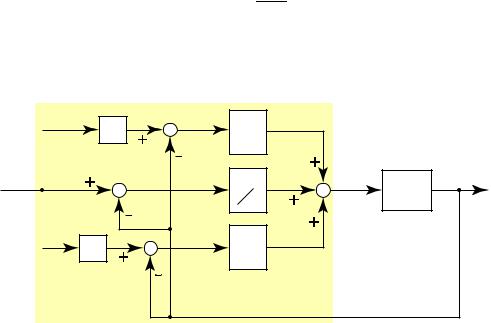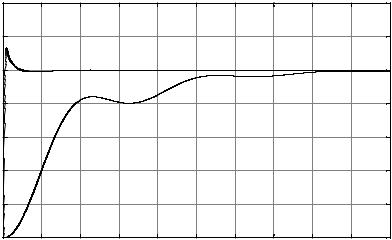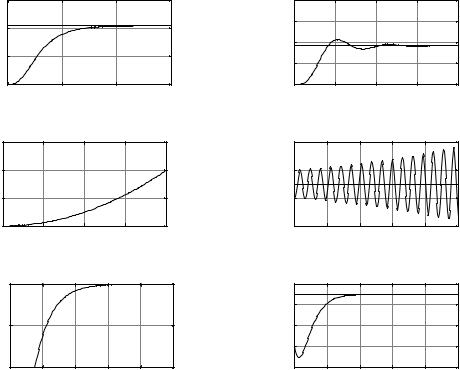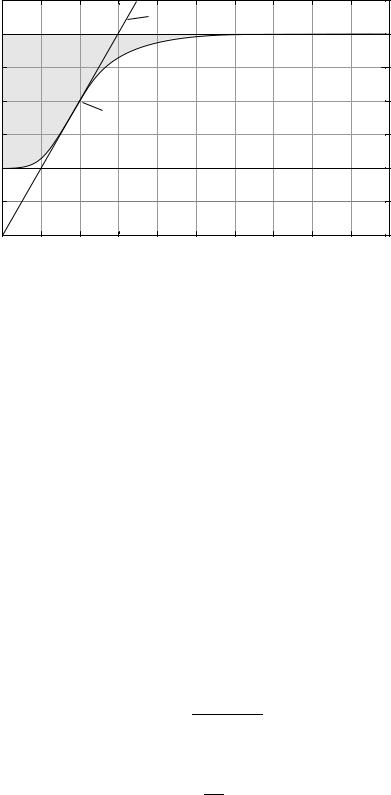
Paz R.The design of the PID controller
.pdfThe Design of the PID Controller
Robert A. Paz
Klipsch School of Electrical and Computer Engineering
June 12, 2001

2
Abstract
The PID controller enjoys the honor of being the most commonly used dynamic control technique. Over 85% of all dynamic (low-level) controllers are of the PID variety. The purpose of this report is to provide a brief overview of the PID controller.
1Introduction
In the control of dynamic systems, no controller has enjoyed both the success and the failure of the PID control. Of all control design techniques, the PID controller is the most widely used. Over 85% of all dynamic controllers are of the PID variety. There is actually a great variety of types and design methods for the PID controller.
What is a PID controller? The acronym PID stands for Proportio-Integro-Di erential control. Each of these, the P , the I and the D are terms in a control algorithm, and each has a special purpose. Sometimes certain of the terms are left out because they are not needed in the control design. This is possible to have a PI, PD or just a P control. It is very rare to have a ID control.
2The Problem Setup
The standard PID control configuration is as shown. It is also sometimes called the “PID parameter form.”
R(s) |
E(s) |
|
|
|
Kp |
|
|
|
|
U(s) |
|
Y(s) |
||||
|
|
|
|
|
|
|
|
|||||||||
|
|
|
|
|
|
|
|
|
||||||||
|
|
|
|
|
|
|
|
|
||||||||
|
|
|
Ki |
|
|
|
|
G(s) |
||||||||
|
|
|
|
|
|
|
s |
|
|
|
|
|
|
|
|
|
|
|
|
|
|
|
|
|
|
|
|
|
|
|
|||
|
|
|
|
|
|
|
|
|
|
|
|
|
|
Plant |
|
|
|
|
|
|
|
|
|
|
|
|
|
|
|
|
|
||
|
|
|
|
|
|
|
Kds |
|
|
|
|
|
|
|
|
|
|
|
|
|
|
|
|
|
|
|
|
|
|
|
|
|
|
|
|
|
|
|
|
|
|
|
|
|
|
|
|
|
|
|
|
|
|
|
|
PID Controller |
|
|
|
||||||||
|
|
|
|
|
|
|
|
|
|
|
|
|
|
|
|
|
Figure 1: PID Controlled System
In this configuration, the control signal u (t) is the sum of three terms. Each of these terms is a function of the tracking error e (t) . The term Kp indicates that this term is

2. THE PROBLEM SETUP |
3 |
proportional to the error. The term Ki/s is an integral term, and the term Kds is a derivative term. Each of the terms works “independently”1 of the other.
2.1Interpretation of the Terms
We now consider each of the terms, assuming that the others are zero. With Ki = Kd = 0, we simply have u (t) = Kpe (t) . Thus at any instant in time, the control is proportional to the error. It is a function of the present value of the error. The larger the error, the larger the control signal. One way to look at this term is that the farther away from the desired point we are, the harder we try. As we get closer, we don’t try quite as hard. If we are right on the target, we stop trying. As can be seen by this analogy, when we are close to the target, the control essentially does nothing. Thus, if the system drifts a bit from the target, the control does almost nothing to bring it back. Thus enters the integral term.
Assuming now that Kp = Kd = 0, we simply have
t
u (t) = Ki e (τ) dτ
0
The addition of this integral makes the open-loop forward path of Type I. Thus, the system, if stable, is guaranteed to have zero steady-state error to a step input. This can also be viewed as an application of the internal model principle. If e (t) is non-zero for any length of time (for example, positive), the control signal gets larger and large as time goes on. It thus forces the plant to react in the event that the plant output starts to drift. We can think of the integral term as an accumulation of the past values of the error. It is not uncommon for the integral gain to be related to the proportional gain by
Ki = Kp τi
where τi is the integral time. Generally, by itself, the I term is not used. It is more commonly used with the P term to give a PI control.. The I term tends to slow the system reactions down. In order to speed up the system responses, we add the derivative term.
Assuming now that Kp = Ki = 0, we have
de (t) u (t) = Kd dt
that is that the control is based on the rate of change of the error. The more quickly the error responds, the larger the control e ort. This changing of the error indicates where the error is going. We can thus think of the derivative term as being a function
1This is not exactly true since the whole thing operates in the context of a closed-loop. However, at any instant in time, this is true and makes working with the PID controller much easier than other controller designs.

4
of the future values of the error. In general, a true di erentiator is not available. This is because true di erentiation is a “wide-band” process, i.e., the gain of this term increases linearly with frequency. It is a non-causal process. It tends to amplify high-frequency noises. In addition, if the error undergoes a sharp transition, for example, when a step input is applied, the derivative skyrockets, requiring an unreasonably large control e ort. Generally, the control signal will saturate all amplifiers etc. To deal with the impractical nature of the D term, it is not uncommon to use the modified derivative
x˙ (t) = |
1 |
(e (t) − x (t)) , u (t) = Kdx˙ (t) |
(1.1) |
τ1 |
where τ1 limits the bandwidth of the di erentiator. In terms of Laplace transform variables, we have
s
L {e˙ (t)} = sE (s) ≈ E (s) (1.2)
τ1s + 1
Thus, for τ1 − small, the approximation is better. This corresponds to the “pole” of the di erentiator getting larger. It is common to let
τ1 = |
Kd |
(1.3) |
|
NKp |
|||
|
|
||
where N is typically in the range from 10 to 20. |
This matter of the di erentiator could |
||
also be viewed using the Taylor expansion of e (t) .
An alternate form of the PID controller is called the “non-interacting form.” In this
form, we have Ki = |
Kp |
, and Kd = Kpτd. In this case, we can factor Kp out of the overall |
||||||||
|
||||||||||
controller |
τi |
|
|
|
|
|
|
|
|
|
u (t) = Kp |
e (t) + τi |
|
0 |
dt |
|
(1.4) |
||||
|
|
|
1 |
|
t |
de (t) |
|
|
||
|
|
|
|
|
|
|
|
|
|
|
The PID control thus considers past, present and future values of the error in assigning its control value. This partly explains its success in usage.
2.2Setpoint Weighting
It is common for the closed-loop system to track a constant reference input. In this case, the input is called a setpoint. This being the case, it is often advantageous to consider an alteration of the overall control law for the sake of this problem. We noted, for instance, that it is not particularly good to di erentiate step changes in the error signal. Changing the configuration will give basically the same behavior, without having to do such things. The setpoint weighted PID is thus a generalization of the PID, and has
u (t) = Kpep (t) + Ki 0 |
t |
|
ded (t) |
|
|
|
ei (τ) dτ + Kd |
(1.5) |
|||
|
dt |
|
|||
where |
|
|
|
|
|
ep = apr (t) − y (t) , ei (t) = r (t) − y (t) , ed (t) = adr (t) − y (t) |
(1.6) |
||||

2. THE PROBLEM SETUP |
5 |
where constants ap and ad are as yet undetermined. Each of the terms thus has a di erent “error” associated with it. Note that when ap = ad = 1, that we have the original PID design. Note also that when r (t) is a piecewise constant signal (only step changes), then for all time (except at the actual step locations), r˙ (t) = 0, and thus,
ded (t) |
= |
d |
(adr (t) − y (t)) = −y˙ (t) |
(1.7) |
dt |
dt |
which is independent of r (t) and ad. In general, since y is the output of the plant, it will be a smooth function and thus y˙ will be bounded. It is thus not uncommon to let
ad = 0. This eliminates spikes in the term Kd ded(t) , without substantially a ecting the
dt
overall control performance.
A block diagram for this is shown. As it appears, it seems much more complicated. However, it is actually not much more complicated.
ap |
Ep(s) |
Kp |
|
|
|
|
|
|
|||
R(s) |
Ei(s) |
K |
i |
U(s) |
Y(s) |
|
|
|
|
G(s) |
|
|
|
|
s |
|
|
|
|
|
|
|
Plant |
ad |
Ed(s) |
Kds |
|
|
|
|
|
|
|||
PID Controller |
|
|
|
|
|
Figure 2: The Setpoint Weighting Configuration
As we have seen, changing ad doesn’t change the overall design. Changing ap, however, may change the design. The rationale behind ap is that if, for example, ap = 0.5, then a large step change in r (t) doesn’t create such a large control magnitude. However, in general, ep does not go to zero when y = r. Thus, there is a persistent control applied even when it is not necessary. The use of this, then is of questionable value. Setting ap = 1, however, brings us back to the original error.
2.3Overall Usage
The PID controller performs especially well when the system has first order dynamics (a single pole). Actually, in this case, the P controller is a state-feedback control! In
6
general, for the system with first-order dynamics the PI control is su cient, and the D is not needed.
For the system with essentially second-order dynamics, the PD control corresponds to state feedback. The PID control generally works well for these systems.
The PID controller can also work for some systems of higher order. Generally speaking, the derivative term is beneficial when the time constants of the system di er by orders of magnitude. It is sometimes helpful when tight control of higher-order dynamics is required. This is because the higher order dynamics prevent the use of high proportional gain. The D provides damping and speeds up the transient response.
The PID controller, of course, is not the end-all of controllers. Sometimes the controller just won’t work very well. The following are cases when the PID control doesn’t perform well. In general, these require the use of more sophisticated methods of control.
•Tight control of higher order process
•Systems with long delay times. In this case, the derivative term is not helpful. A “Smith predictor” is often used in this case.
•Systems with lightly damped oscillatory modes
•Systems with large uncertainties or variations.
•Systems with harmonic disturbances
•Highly coupled multi-input, multi-output systems—especially where coordination is important.
2.4Example
Consider the system given by the transfer function |
|
|
|
||||||||
G (s) = |
|
|
20 (s + 2) |
|
|
|
|||||
|
|
|
|
|
|
|
|||||
s + 21 (s2 + s + 4) |
|||||||||||
|
|
|
|
||||||||
If we use the (modified) PID controller |
|
|
|
|
|
|
|||||
C (s) = Kp + |
|
Ki |
+ |
Kds |
|
|
|
|
|||
|
s |
|
τ1s + 1 |
|
|
|
|||||
|
|
|
|
|
|
|
|
||||
= |
(Kpτ |
1 + Kd) s2 + (Kp + Kiτ1) s + K1 |
|||||||||
|
|
|
|
|
s (τ1s + 1) |
|
|
|
|||
|
|
|
|
|
|
|
|
|
|||
where |
|
|
|
|
|
|
|
|
|
||
Kp = 9, Ki |
= 4, Kd = 1, τ1 = |
1 |
|
||||||||
100 |
|||||||||||
|
|
|
|
|
|
|
|
||||
We use the following MATLAB code to simulate the system:
(1.8)
(1.9)

2. THE PROBLEM SETUP |
7 |
num=20*[1 2];den=conv([1 .5],[1 1 4]);
Kp=9;Ki=4;Kd=2;t1=1/100;
numc=[Kp*t1+Kd,Kp+Ki*t1,Ki]/t1;denc=[t1,1,0]/t1;
numf=conv(num,numc);denf=conv(den,denc);
dencl=denf+[0 0 numf];
numy=numf;
syso=tf(num/20,den);sysy=tf(numy,dencl);
t=[0:.002:10]’;
yo=step(syso,t);yc=step(sysy,t);
figure(1);plot(t,[yo yc]);grid
xlabel(’time (sec)’);ylabel(’y(t)’)
We thus obtain the plot shown. This plot compares the open-loop response with that of the PID controlled response. For the open-loop, we simply scaled the step input so that the overall system output settled out to 1.
y(t)
1.4
1.2
closed loop
1
0.8
open loop
0.6
0.4
0.2
0
0 |
1 |
2 |
3 |
4 |
5 |
6 |
7 |
8 |
9 |
10 |
time (sec)
Figure 3: Step Response for PID and Open-Loop Systems
We see that the PID controlled system performs much better than the open loop. It is often advantageous to make a comparison with the open-loop system, since that shows what would happen using the simplest kind of control. Indeed, the open loop requires no sensors and is thus much less costly to build and maintain than the PID system. If the PID system did not perform so much better, it might not be worthwhile.

8
3Plant Modeling
In general, the more we know about a system, the better we will be able to control it. If we know nothing about a system, we better not be trying to control it. A logical question, then, is how much (or little) do we need to know, and how will we obtain that data?
3.1Information Required
The more information available about the system, the better it can be controlled2. Many processes to be controlled are either di cult to model or else it is di cult to obtain the parameters for the model. For example, the dynamic inductance of a dc motor is very di cult to obtain. Generally, to obtain a model, it is necessary to perform some experiments to obtain actual parameter values. The type of experiments will determine what data is obtained. Here, we consider three types of experiments. Each will give a di erent type of information. That information will be used to design the PID controller.
In general, the experiments to be performed require that the system be stable. If not, the experiments won’t work. This, of course, is a great restriction. Unless the exact model of the unstable system is known, there is no known way to tune a PID controller. Some controllers, such as adaptive controllers are able to compensate for unstable systems, however their complexity excludes them from consideration in this course.
3.2Step Response Information
A simple experiment to perform is the step response test. Here, we assume a unit step is applied to the system, although it is also possible to scale the whole experiment is necessary. From the results of this test, the data may be used to obtain approximations of the system.
Figure 4 shows example step responses for a number of di erent possibilities. The tuning rules were essentially developed for a step response of type A. The rules, however, may work for responses of type B and E. The responses C and D are for unstable systems. If the plant is exactly known, it might be possible to design a PID controller, but there is no guarantee. As for the system with response F, the system has a zero in the RHP (unstable zero). A PID controller may reduce the settling time of the system, but is likely to accentuate the undershoot.
The PID controller rules are thus essentially designed for a first or second-order, nonoscillatory system with possibly some time-delay. An example plot is shown in Figure 5.
The step response has several values that are of importance in obtaining an approximate transfer function for the system. First, we see yss which is the steady-state value for the step input. Next, we see y0, τ0, and m, which gives a linear approximation of the
2There are limits, of course, as to what can be achieved.

3. PLANT MODELING |
9 |
15 |
|
|
|
10 |
|
|
|
A |
|
smooth |
|
5 |
|
|
|
00 |
10 |
20 |
30 |
|
|
time (sec) |
|
3 |
|
|
|
|
2 |
|
|
|
|
C |
|
|
unstable |
|
1 |
|
|
|
|
|
|
|
|
|
00 |
0.5 |
1 |
1.5 |
2 |
|
|
time (sec) |
|
|
1 |
|
|
|
|
|
E0.5 |
|
|
|
|
|
00 |
|
time-delay |
|
|
|
2 |
4 |
6 |
8 |
10 |
|
|
|
time (sec) |
|
|
|
0.8 |
|
|
|
|
0.6 |
|
oscillatory |
|
|
B0.4 |
|
|
||
|
|
|
|
|
0.2 |
|
|
|
|
00 |
5 |
10 |
15 |
20 |
|
|
time (sec) |
|
|
4 |
|
|
|
|
|
2 |
|
|
|
|
|
D |
|
|
|
|
|
0 |
|
|
|
|
|
-20 |
unstable,oscillatory |
|
|
||
2 |
4 |
6 |
8 |
10 |
|
|
|
time (sec) |
|
|
|
|
3 |
|
|
|
|
|
|
2 |
|
|
|
|
|
F |
1 |
|
|
|
|
|
|
|
|
|
|
|
|
|
0 |
undershoot |
|
|
|
|
|
-10 |
|
|
|
||
|
2 |
4 |
6 |
8 |
10 |
|
|
|
|
time (sec) |
|
|
|
Figure 4: Six Possible Step Responses

10
y(t)
Line: mt - y0
yss
A0
m = steepest slope of y = y.max
0
-y0 |
0 |
t0 |
tmax |
time (sec) |
|
Figure 5: A Typical Step Response
transient portion of the step response. Given only the step response data, we first find the point at which the derivative of y is at a maximum. This value is y˙max and occurs at time tmax. The equation of the line that passes through the point y (tmax) with slope m = y˙max is given by
Line: |
(y˙max) t + y (tmax) − (y˙max) (tmax) |
(1.10) |
|||
which is indeed a linear function of time t. From this, we may determine |
|
||||
y0 |
= |
(y˙max) (tmax) − y (tmax) |
(1.11) |
||
τ0 |
= |
|
y0 |
|
(1.12) |
|
y˙max |
||||
Here, τ0 is often called the apparent dead time. In this case, we may approximate the plant by the model
Ga1 (s) = |
y0 |
|
e−sτ 0 |
(1.13) |
τ0 |
s |
which doesn’t match the steady-state characteristics very well, but does match the transient portion in a linear fashion. A model that approximates the system’s steady-state behavior is given by
Ga2 (s) = |
yss |
(1.14) |
1 + (τar) s |
where yss is the steady-state value of y and τar and is given by
τar = A0
yss
is the so-called average residence time,
(1.15)
